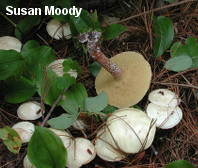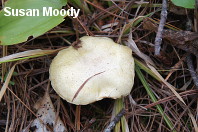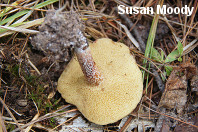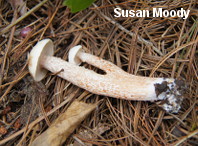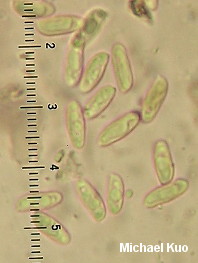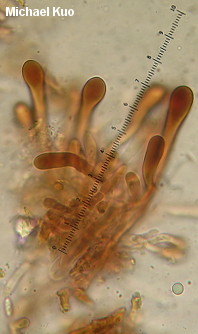| Major Groups > Boletes > Suillus > Suillus placidus |

|
[ Basidiomycota > Boletales > Suillaceae > Suillus . . . ] Suillus placidus by Michael Kuo, 19 November 2022 This easily identified Suillus features a bald white cap and a slender stem that develops conspicuous glandular dots and smears that contrast with the stem surface. It is apparently exclusively associated with eastern white pine, and can be found throughout the range of the host tree (northeastern North America, south through the Appalachians). Pale or faded specimens of Suillus weaverae can be very similar but usually have stems that develop yellow shades and are slightly more thick, proportionally. Boletus albus Peck (1872) is probably the same mushroom, according to Snell (1933, 1970). Thanks to Susan Moody for collecting, documenting, and preserving Suillus placidus for study; her collection is deposited in The Herbarium of Michael Kuo. Description: Ecology: Mycorrhizal with Pinus strobus (eastern white pine); growing alone, scattered, or gregariously; summer and fall; originally described from Germany (Bonorden 1861), but appearing in Europe only with imported Pinus strobus; fairly widely distributed in northeastern North America, west to the Dakotas and southward with the Appalachian Mountains—corresponding with the natural range of the host tree (see the map on the linked page); reports from China and Japan probably represent a different species. The illustrated and described collection is from Minnesota. Cap: 4–9 cm; convex becoming broadly convex or nearly flat; sticky when fresh; white when young, darkening slightly with maturity to yellowish white or nearly yellowish; bald or nearly so; in age the gluten sometimes drying brownish. Pore Surface: White when very young, becoming dull yellow; not bruising; pores becoming angular, about 1–2 per mm; tubes to 1 cm deep. Stem: 4–9 cm long; 5–12 mm thick; more or less equal above a somewhat tapered base; sticky when fresh; whitish underneath conspicuous, large glandular dots and smears that are initially pinkish but soon darken to reddish brown or brown; without a ring; basal mycelium white. Flesh: Whitish to yellowish; often staining slowly pinkish to reddish when sliced, especially in the stem base. Odor and Taste: Not distinctive. Chemical Reactions: Ammonia on cap surface pink, then black to dull red or purple; on flesh pink to red, becoming purplish or grayish. KOH on cap surface pink, becoming black or purple; on flesh pink. Spore Print: Cinnamon brown. Microscopic Features: Spores 7–9 x 2–3 µm; fusiform; smooth; yellowish in KOH. Basidia about 25 x 4 µm; subclavate; 4-sterigmate. Cystidia in bundles; to about 80 x 8 µm; clavate to subcapitate; smooth; pinkish red to reddish brown in KOH. Pileipellis an ixocutis. REFERENCES: (H. F. Bonorden, 1861) R. Singer, 1945. (Saccardo, 1888; Snell, 1933; Coker & Beers, 1943; Snell & Dick, 1961; Smith & Thiers, 1964; Snell & Dick, 1970; Smith & Thiers, 1971; Grund & Harrison, 1976; Smith, Smith & Weber, 1981; Weber & Smith, 1985; Breitenbach & Kränzlin, 1991; Phillips, 1991/2005; Lincoff, 1992; Both, 1993; Barron, 1999; Bessette, Roody & Bessette, 2000; McNeil, 2006; Klofac, 2013; Nguyen at el., 2016; Kibby, 2017; Noordeloos, 2018; Sturgeon, 2018; Læssøe & Petersen, 2019; McKnight et al., 2021.) Herb. Kuo 09121403. This site contains no information about the edibility or toxicity of mushrooms. |
© MushroomExpert.Com |
|
Cite this page as: Kuo, M. (2022, November). Suillus placidus. Retrieved from the MushroomExpert.Com Web site: http://www.mushroomexpert.com/suillus_placidus.html |
